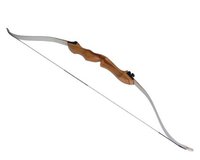Posted by Heidi C on 10th May 2016
Is a recurve bow good for beginners?
Deciding on how to choose a recurve bow is much easier than you could imagine. Looking through all the different models out there, you might have gotten somewhat confused. This is normal for a beginner, but the truth is you choose any recurve to start with and you will be very happy with the outcome, as long as you accurately answer this question:
Is a recurve bow good for beginners

What Do You Want to Use it For?
Do you want to use your recurve for hunting, or target practice?
If you want a bow for target practice only:
If you have been weight training for a period of time and want to see results a bit more quickly, work on your large groups of muscles, such as those in your legs, back and chest. Some great exercises for those groups are deadlifts, squats, bench presses, dips and military presses.
Pretty much any bow will do. You should simply choose one from among our best 10 recurve bows, or just view our shorter list of beginner recurve bows. We only list the highest quality bows on those lists, and each of them is a good choice for target practice, regardless of your level of skill. So you can pretty much just buy one which is within your budget and which looks good to you – our recurve bow reviews will help you understand the pro’s and con’s of each model.
If you want a bow for hunting:
While every single recurve bow is suitable for target practice, not all will be suitable for hunting. However – and this is important to understand – the main parameter that determines if you can hunt with your recurve is the draw weight on the bow, not the actual model you purchase. In case you don’t know, draw weight refers to the amount of force you need to apply to the bow string in order to pull it over a distance of 28″ (in the case of recurve bows). The higher the draw weight on your bow, the more powerful it will be and the further your arrow will travel (and with more force).
When target practicing, you don’t need a very powerful bow. Your arrow only needs to penetrate the foam or cardboard of your bullseye, which doesn’t require much energy. On the other hand, when you’re hunting, your arrow often needs to go through the thick skin, fat tissue, and sometimes even the bone of your pray.
So what’s the solution? Simple: choose a recurve bow which has a draw weight of 40 pounds minimum. Now, you can hunt perfectly well for smaller game like turkey and rabbit with a 35 or even 30 lbs. bow, but for anything larger than that (deer, elk) you’ll need 40 lbs. or more. But there’s a small catch here: not all beginners are capable of handling a 40 and higher draw weight bow. So how do you determine whether you can handle it if you’ve never shot a recurve bow?
It’s worth remembering that you can quickly build up your draw weight as soon as you start. So while you might not be able to handle more than 30 lbs., after a few weeks or months of practice a 40 pounder will be more than manageable. Also, it is advisable that you focus on muscle building in order for you to be able in handling the heavier draw weight. Train at least three times per week. You need at least three training sessions every week if you want to see significant muscle growth. If you are really new at weight training, this can be reduced to two at the start; however, you should increase the number of sessions per week as soon as you are able. If you already have some experience with strength training, you can add more sessions as well. You need to be focused on what you are striving to achieve when looking to build your muscles.
For the meantime, settle with the draw weight that you can handle and aim higher once you are able to.

